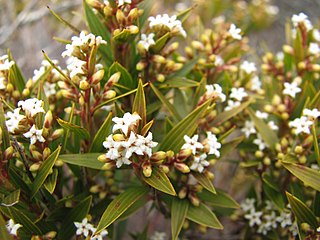
Leucopogon neurophyllus, commonly known as veined beard-heath, is a species of flowering plant in the heath family Ericaceae and is endemic to Victoria in Australia. It is a dense shrub with many branches, erect, narrowly elliptic leaves, and white, tube-shaped flowers that are densely bearded inside.

Boronia filifolia, commonly known as the slender boronia, is a plant in the citrus family Rutaceae and is endemic to south-eastern Australia. It is a slender shrub with simple or pinnate leaves and pale to deep pink four-petalled flowers.

Leucopogon plumuliflorus is a species of flowering plant in the heath family Ericaceae and is endemic to the south-west of Western Australia. It is a weakly erect shrub with egg-shaped leaves and spikes of white or pinkish-white, tube-shaped flowers.
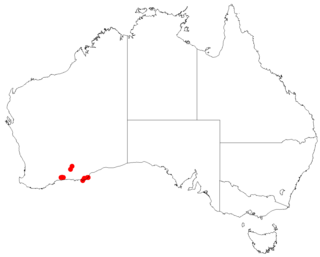
Leucopogon bossiaea is a species of flowering plant in the heath family Ericaceae and is endemic to a restricted area in the south-west of Western Australia. It is an erect shrub with elliptic to broadly egg-shaped leaves and white flowers in four to eleven upper leaf axils.

Styphelia cordifolia, commonly known as heart-leaved beard-heath, is a species of flowering plant in the heath family Ericaceae and is endemic to Australia. It is an erect shrub with broadly egg-shaped to round leaves, and white, tube-shaped flowers, the petals bearded on the inside.

Styphelia breviflora is a species of flowering plant in the heath family Ericaceae and is endemic to the south-west of Western Australia. It is an erect, spindly, glabrous shrub that typically grows to a height of up to about 1.5 m. It has oblong to lance-shaped or linear leaves 4–9 mm (0.16–0.35 in) long on a short petiole and with a small, rigid point on the tip. The flowers are borne singly or in pairs in leaf axils on a short peduncle with small bracts and bracteoles about half as long as the sepals. The sepals are about 2 mm (0.079 in) long and the petals white and about 4 mm (0.16 in) long, the petal lobes longer than the petal tube.

Styphelia exolasia, commonly known as Woronora beard-heath, is a species of flowering plant in the heath family Ericaceae and is endemic to a small area of New South Wales. It is an erect shrub with oblong or elliptic leaves, and drooping, white, tube-shaped flowers.

Styphelia flavescens is a species of flowering plant in the heath family Ericaceae and is endemic to the south-west of Western Australia. It is a shrub with oblong leaves and white, tube-shaped flowers that are densely bearded on the inside.

Cryptandra longistaminea is a species of flowering plant in the family Rhamnaceae and is endemic to eastern Australia. It is a shrub with many branches, egg-shaped or elliptic to linear leaves, and clusters of white, tube-shaped flowers.

Leucopogon opponens is a species of flowering plant in the heath family Ericaceae and is endemic to the south-west of Western Australia. It is an erect, slender shrub with its leaves arranged in opposite pairs, and white, tube-shaped flowers.
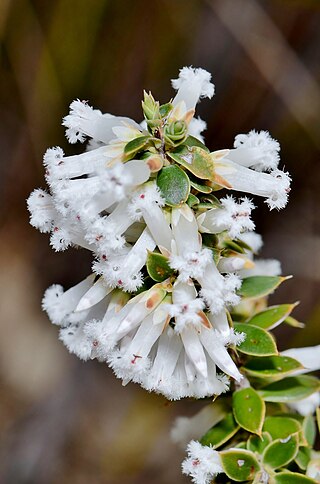
Styphelia erubescens is a species of flowering plant in the heath family Ericaceae and is endemic to the south-west of Western Australia. It is an erect shrub with variably-shaped leaves with a small, sharp point on the tip, and white, pink or red, tube-shaped flowers.
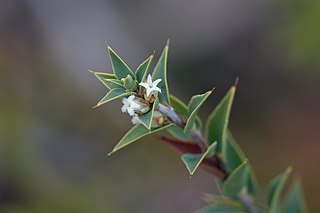
Styphelia rufa, commonly known as spoon-leaf beard-heath or ruddy bearded-heath, is a species of flowering plant in the heath family Ericaceae and is endemic to south-eastern continental Australia. It is an erect shrub with erect to spreading, egg-shaped leaves and white, tube-shaped flowers arranged in spikes in two to five leaf axils near the ends of branches.

Styphelia strongylophylla is a species of flowering plant in the heath family Ericaceae and is endemic to the southwest of Western Australia. It is an erect shrub with crowded egg-shaped or round leaves and white, tube-shaped flower arranged singly or in pairs in leaf axils.
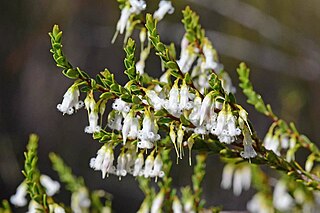
Styphelia woodsii, commonly known as nodding beard-heath, is a species of flowering plant in the heath family Ericaceae and is endemic to southern continental Australia. It is a slender shrub with more or less erect, egg-shaped leaves, and pendent white, tube-shaped flowers with densely bearded lobes.

Styphelia exarrhena, commonly known as desert styphelia, is a species of flowering plant in the heath family Ericaceae and is endemic to southern continental Australia. It is an erect shrub with erect or spreading egg-shaped leaves, and cream-coloured, tube-shaped flowers arranged singly or in pairs in upper leaf axils.
Styphelia exserta is a species of flowering plant in the heath family Ericaceae and is endemic to the south-west of Western Australia. It is an erect shrub with broadly egg-shaped leaves, and white, tube-shaped flowers.

Styphelia hainesii is a species of flowering plant in the heath family Ericaceae and is endemic to the south coast of Western Australia. It is a bushy shrub with egg-shaped leaves, the narrower end towards the base, and red, tube-shaped flowers arranged singly in leaf axils.

Styphelia lissanthoides, formerly Leucopogon cuneifolius, is a species of flowering plant in the heath family Ericaceae and is endemic to the south of Western Australia. It is an erect, bushy shrub with egg-shaped to lance-shaped leaves with the narrower end towards the base, and white, tube-shaped flowers arranged singly or in pairs in leaf axils.

Lissanthe pluriloculata is a species of flowering plant in the family Ericaceae and is endemic to Queensland. It is a small, bushy shrub with sharply-pointed linear leaves and spikes or racemes of tube-shaped, white flowers.
Styphelia subulata is a species of flowering plant in the heath family Ericaceae and is endemic to the south-west of Western Australia. It is a rigid shrub with many branches, usually sharply-pointed, linear leaves and usually one or two white, tube-shaped flowers in leaf axils.



















